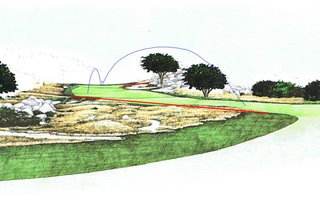Carry Angles
Carry angles are the simplest form of risk and reward. The hazard is placed on a diagonal to play, and the player is left to choose how much of the hazard they are going to try and carry. The more they try to carry, the longer the shot, but the easier the approach is into the green. The less they risk, the shorter the shot, and the tougher the approach into the green.
In the drawings the first red line of the drawing represents the carry angle. The second red line at the green represents another carry angle. The second line also illustrates the reason for trying bite off as much as you dare from the first angle. If you play wide to the left, you are left with a full carry over the hazard; but if you can play over the diagonal hazard successfully, you are left with a clear pitch into the green. This is very simple risk and reward architecture.
The reasons that I like carry angles to create strategy are:
1. risk and reward scenarios encourage more aggressive and exciting play
2. they clearly defend the shortest route to the hole without removing the aggressive play
3. they create varying degrees of risk depending on ability of the player
4. this style makes strategies very obvious and the ideal line very clear for players
Architect who most typifies this example:
1. William Flynn, the master strategist used this style predominantly in his work.
2. Canadian Doug Carrick uses this approach on most of his holes.
3. Bob Cupp enjoys this technique a great deal too.
The reasons I don’t like to overuse carry angles:
1. Technology renders these holes obsolete very easily since it is based upon a precise carry distance
2. When carry angles are overused, the player begins to make automatic decisions, which lessens the interest for the player.
3. Most carry angles are created by the architect, usually using bunkers, and there ends up being too much repetition in what the player sees.
4. While strategically strong, there is too little fun, chance and discovery left in the course. I think this architecture can fail by being too planned out to enjoy.
My thoughts about using this technique:
1. It remains one of the best techniques to use to challenge a player mentally
2. Do not use this exclusively since the best architecture mixes many styles. One strategy is dull, no matter which one you choose.
3. This is best used by finding a natural carry angle in a creek or ridge to avoid repetition
4. Alternate with other techniques like triangulation, doesn’t get compromised by technology.

2 comments:
Wow, I thought golf was a game of just banging a little white ball around and following it until everyone gets thirsty enough to retire to the bar! Clearly I'm in error - there's a lot more to the game than meets the eye.
Cool story you got here. It would be great to read something more about this theme.
By the way check the design I've made myself Russian escort
Post a Comment